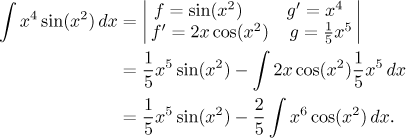Problem: Evaluate the integral
![]()
Solution:
When we look at an integral we usually first think of substitution. Here an
idea occurs to simplify the composed function by substitution, usually we
take for y the inner function x2. To succeed we
would have to find

This would look like the perfect integral for integration by parts, namely the type "removing powers", but for a small detail: The power at y is not an integer. Therefore we cannot make it go away using differentiation and integration by parts fails. No other reasonable solution presents itself, so this substitution worked, but it lead to an integral that we cannot solve with our tools.
We have to look for some alternative. His integral does not fit into any box related to special types, and concerning basic methods we already ruled out substitution and partial fractions are obviously no good here. What remains is integration by parts.
This actually seems like the natural choice. The integrated function is already written as a product, one part of which is a power of x that can be removed by repetaed differentiation. However, we run into trouble with the second requirement that the other part should be easily integrable. Let's see: We choose the natural choice.
![]()
Now we easily find
![]()
and this integral cannot be evaluated by any of the methods we cover here.
Why is it so? The only reasonable substitution would be
Now we try to switch the functions:

Here we managed to calculate the necessary expressions and use integration by parts; however, the new integral we obtained is even worse than the one we started with.
What is the right way then? The key to success is our very first attempt. When we tried the natural setting for integration by parts, we had troubles getting g. However, we saw that integration works if we have an extra x.

That extra x is easy to arrange, we move one x from
f to

Yes, that's how it is supposed to work, the integral stayed basically the same but the power at x decreased. So it's one more time.

We ended up with an integral that we gave up on earlier. Given that this was
our last chance, it is time to ask whether we are sure that none of our
tricks would work on this one. Unfortunately, the answer is in the positive.
Not just our methods, it is known that the integral of
Since every integration by parts decreases power by two, we see that when we
integrate
So much for classical methods. How about some non-classical methods? There is a way using power series. We expland the sine and the rest is easy (if you know how to handle infinite series).

This answer is not exactly what we usually accept, but there are applicacions where this is preferable to no answer.